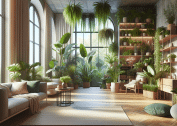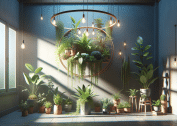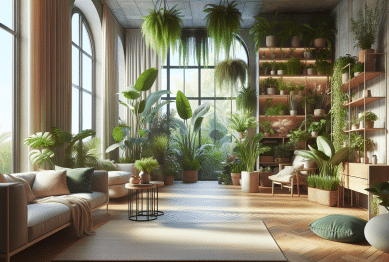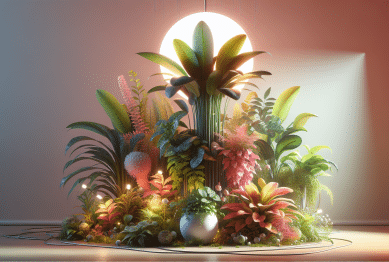Discover creative small space garden ideas designed for balconies, patios, and tiny yards. Explore vertical gardening, container plant solutions, and sustainable practices that can transform even the most compact spaces into vibrant, productive retreats. This guide reveals what works, how to start, and clever ways to maximize every inch.
Understanding Small Space Gardening Principles
Small space gardening makes it possible to grow flowers, herbs, and even vegetables in areas many overlook. It’s about efficient use, clever planning, and embracing container gardening as a core strategy. Working with limited space means selecting plants that thrive in confined containers or vertical frames, optimizing sunlight exposure, and choosing adaptable species. This focus allows anyone in apartments or houses with modest yards to cultivate greenery and enjoy the mental health benefits tied to nature exposure (Source: https://www.ncbi.nlm.nih.gov/pmc/articles/PMC5663018/).
Embracing container gardening means flexibility. Pots, troughs, window boxes, and raised beds enable unique layouts, letting one move plantings to chase the sun or take shelter during harsh weather. Different plants require different soil types and watering routines. Compact gardens allow experimentation with these combinations in smaller, more manageable batches. Portable gardens also help renters or those with temporary outdoor spaces create homey, customized environments.
The practice also revolves around vertical growing and multi-use zones. Vertical gardens extend capacity—think wall planters, trellises, or hanging gardens. These methods don’t just save floor space; they often reduce pests and can improve air quality by clustering more foliage in a small area. Planning ahead supports year-round interest. Mix evergreens with seasonal color to keep the space fresh and engaging at any time.
Choosing the Right Plants for Limited Spaces
Plant selection is the cornerstone of successful small space gardens. Dwarf varieties, trailing vines, compact shrubs, and herbs are frequent choices. Edible options like cherry tomatoes, salad greens, chillies, and strawberries do especially well in containers or vertical gardens. These plants tend to need less soil volume and can adapt to various light levels, making them ideal for balconies or patios. Choosing species with similar care requirements simplifies maintenance (Source: https://www.rhs.org.uk/gardening-for-health/small-spaces).
Ornamental plants shouldn’t be overlooked either. Succulents, dwarf blooming annuals, and evergreens provide visual structure throughout the year. Layering textures, foliage colors, and heights builds depth even in the smallest beds or pots. This design approach turns any tiny space into an inviting oasis, perfect for relaxing or entertaining guests. For shadier spots, ferns or shade-loving hostas thrive while softening harder architectural edges.
Mixing edibles with ornamentals brings additional value. Herbs, when nested among flowers, offer beauty and function, deterring pests naturally. These mixed plantings not only maximize productivity in a confined area but also encourage biodiversity, supporting pollinators and other beneficial insects. They give a sense of abundance that surprises, delighting anyone who visits or tends the mini oasis.
Vertical Gardening Methods and Tips
Limited floor space need not limit plant volume. Vertical gardening introduces shelves, wall hangers, trellises, and towers into the design. These structures let you stack or layer different containers, producing more lush growth in less square footage. DIY options range from simple stacked pots to elaborate pallet gardens. Each solution can accommodate various budgets and skill levels (Source: https://garden.org/learn/articles/view/4393/).
Climbing plants such as peas, beans, and morning glories suit trellises perfectly, while small-leafed vines excel in wall planters. Creating living walls using modular panels or hanging pouches is another way to boost greenery density. Even herbs like basil and oregano can be grown in small pockets attached to fences or the side of a balcony. The beauty of vertical systems lies in their adaptability—move or refresh them whenever you want a change.
Maintaining vertical setups requires a few considerations. Watering can be tricky, as upper tiers dry out more quickly than ground-level pots. Drip irrigation systems or self-watering planters help ensure consistent moisture. Choosing lightweight soils and proper drainage prevents overwatering or root rot. With simple adjustments, these vertical ideas keep gardens thriving even under challenging urban or small-yard conditions.
Container Gardening Tricks for Maximum Yield
Container gardens are versatile and perfect for maximizing output in restricted zones. The key lies in choosing the right pot, soil, and placement for each plant. Large pots allow multiple varieties or companion plant combinations that support health and pest resistance. Small pots give control over individual needs, making it easy to swap out any failing plant. Selecting the correct container size promotes stronger roots and reduces stress for the plants (Source: https://www.gardeners.com/how-to/container-gardening/5158.html).
Soil quality matters greatly in a container garden. Lightweight potting mixes retain moisture without compacting roots while allowing excess water to drain. Regular feeding with organic compost or slow-release fertilizers keeps growth healthy. Containers dry out more quickly than traditional beds, so routine water checks are vital—especially in full sun areas. Mulching also helps regulate moisture levels for efficient use of water.
Placement counts just as much as any other consideration. Mobile containers can be moved to take advantage of changing light throughout the seasons. Wheels or plant caddies enable rotation, while trellis supports stimulate upward growth in small areas. Grouping similar plants together creates mini microclimates that foster more consistent growth and discourage pests. Thoughtfully curated container gardens transform any spare corner into a beautiful, productive patch.
Creative Upcycling and DIY Garden Solutions
Repurposing and upcycling everyday items for gardening purposes is not just budget-friendly; it’s also highly sustainable. Old ladders, pallets, buckets, or even shoe organizers become imaginative planters and vertical structures in limited spaces. This approach minimizes waste, inspires creativity, and often produces unique conversation pieces. Upcycled gardens allow for personal expression while serving a practical role in small-scale gardening (Source: https://www.epa.gov/recycle/reducing-waste-what-you-can-do).
Projects might include turning tin cans into decorative herb planters, using wooden crates stacked for strawberries, or constructing a pallet frame to mount succulents vertically. These solutions offer custom fit for specific dimensions—ideal for oddly shaped balconies or small patios. Not only do upcycled items extend the planting area, they make efficient use of existing resources, supporting broader sustainability goals.
Upcycling is also a great way to involve family or housemates, fostering teamwork and eco-friendly habits. Painting or personalizing repurposed planters adds character and joy. By focusing on what can be made instead of bought, gardeners can stay within budget while creating one-of-a-kind spaces that inspire long after planting. These projects are often adaptable as needs or seasons change.
Sustainable Practices in Compact Gardening
Sustainability and conservation are important, especially when working with limited resources. Small space gardens lend themselves well to eco-friendly gardening tactics, including composting kitchen scraps for soil enrichment, collecting rainwater, and growing native or drought-resistant plants. These methods naturally reduce water usage and chemical dependency, benefitting both the gardener and the environment (Source: https://www.usda.gov/media/blog/2013/10/31/urban-gardening-and-farming-growing-sustainable-future).
Integrated pest management (IPM) fits perfectly in compact gardens. This approach uses mechanical, cultural, and sometimes organic solutions—like introducing beneficial insects—to maintain plant health. Planting marigolds among edibles can deter harmful bugs, while spacing ensures good air flow to prevent diseases. Compost bins, even in small sizes, recycle green waste and reduce landfill impact.
Designing for biodiversity further supports sustainability. Mixing flowers, herbs, and vegetables, or letting some plants flower and seed, encourages a healthy insect community and improves pollination rates. These techniques blend beauty and function, keeping small gardens vibrant and resilient. Smart planning assures consistent enjoyment with minimal ecological footprint.
References
1. Bratman, G. N., Anderson, C. B., Berman, M. G., Cochran, B., de Vries, S., Flanders, J., & Gross, J. J. (2019). Nature and mental health: An ecosystem service perspective. Retrieved from https://www.ncbi.nlm.nih.gov/pmc/articles/PMC5663018/
2. Royal Horticultural Society. (n.d.). Small space gardening. Retrieved from https://www.rhs.org.uk/gardening-for-health/small-spaces
3. National Gardening Association. (n.d.). Stack It Up: Vertical Gardening. Retrieved from https://garden.org/learn/articles/view/4393/
4. Gardener’s Supply Company. (n.d.). Container Gardening. Retrieved from https://www.gardeners.com/how-to/container-gardening/5158.html
5. United States Environmental Protection Agency. (n.d.). Reducing Waste: What You Can Do. Retrieved from https://www.epa.gov/recycle/reducing-waste-what-you-can-do
6. United States Department of Agriculture. (2013). Urban Gardening and Farming: Growing a Sustainable Future. Retrieved from https://www.usda.gov/media/blog/2013/10/31/urban-gardening-and-farming-growing-sustainable-future









